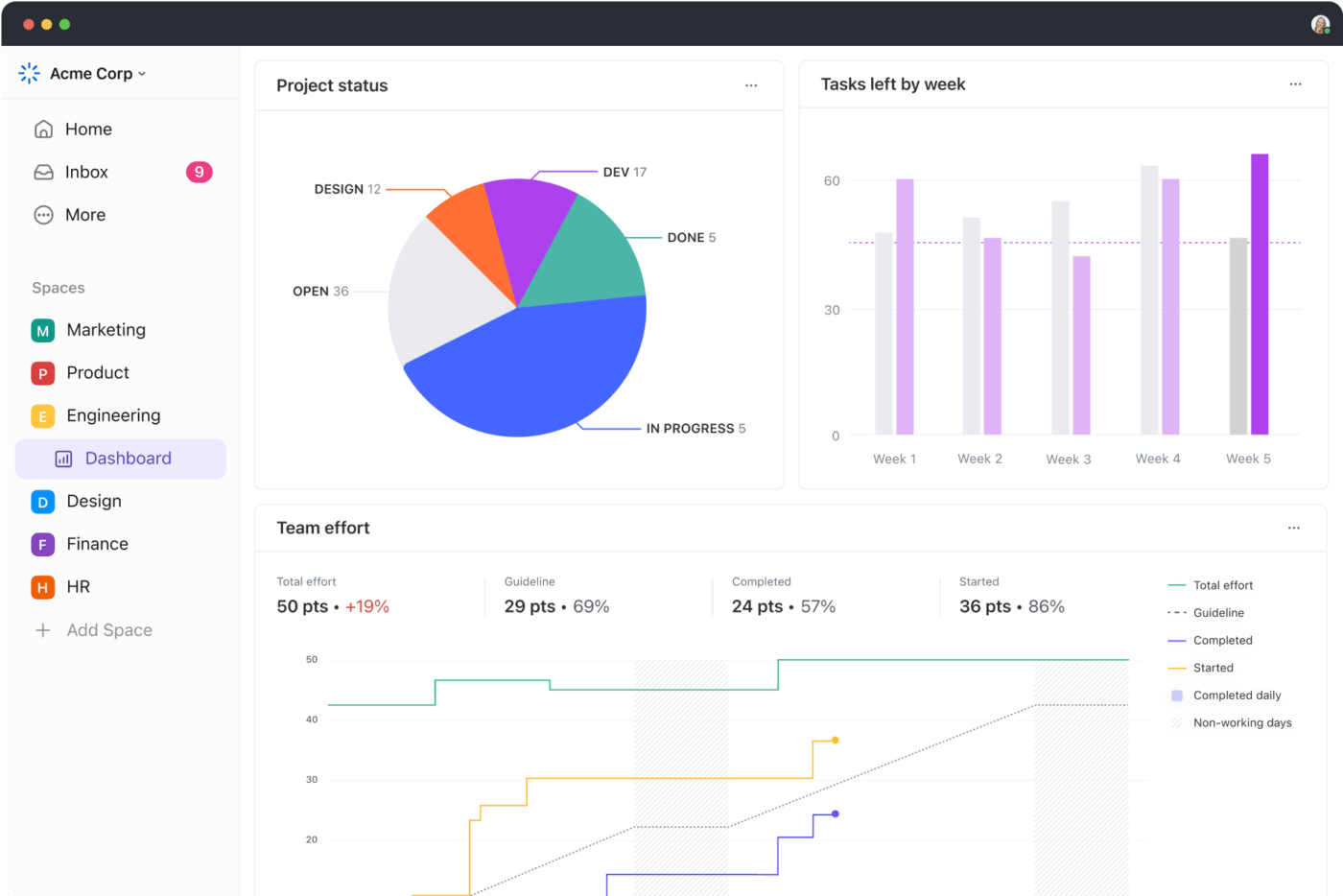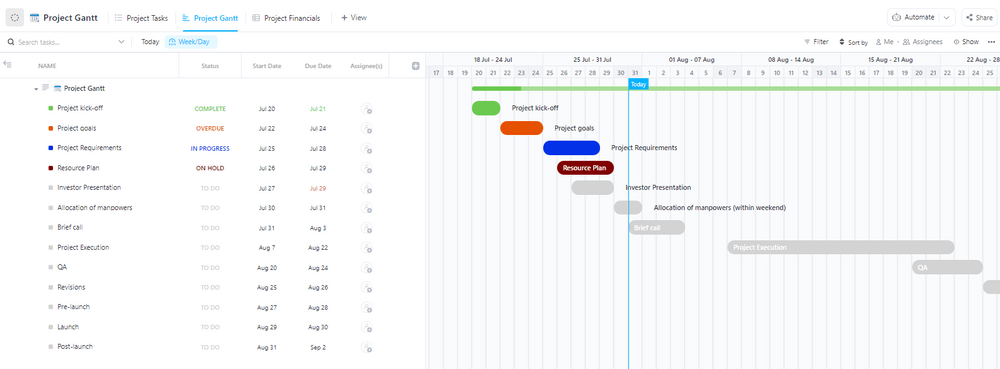

Although project, program, and portfolio management are commonly used in the workplace, the distinctions between them can be unclear.
While the terms sound identical, and some err on the side of using them interchangeably, they represent distinct levels of planning, organization, and execution. Think of them as different interrelated layers of management.
Understanding the nuanced differences between project vs. program vs. portfolio management will help strategize resource allocation, achieve long- and short-term goals, and maximize value delivery.
On that note, here’s a rundown of these terms, their differences, and how they contribute to overall organizational success.
What Is Project Management?

A project is a temporary endeavor undertaken to convert a brilliant idea into a viable, unique, and successful product, service, or result that aligns with the business vision. Project management involves coordinating resources and activities while managing stakeholders to deliver successful project outcomes.
To do this, project managers make use of software solutions for planning, organizing, executing, monitoring, controlling, and reporting on tasks within a project. At the same time, project managers are also responsible for managing stakeholder interests and expectations and cultivating strong relationships.
The Project Management Institute (PMI) defines project management as “the application of knowledge, skills, tools, and techniques to project activities to meet project requirements.”
Strategic objectives of project management
The key objectives of project management include:
- Submitting project deliverables on time, as per specifications, within budget, and within scope
- Maximizing resource utilization and ensuring resource availability
- Anticipating, identifying, assessing, and mitigating project risks
- Maximizing return on investment (ROI) while meeting or exceeding customer expectations
- Cultivating a culture of teamwork and collaboration among key stakeholders
- Ensuring adherence to best practices and quality standards while also employing project management hacks
- Improving project management practices, processes, and methodologies continuously
Roles and responsibilities of a project manager
A project manager is typically involved in:
- Defining and documenting project scope, goals, constraints, and deliverables
- Developing and managing project plans, schedules, and budgets and adhering to these commitments
- Assembling and leading project teams, assigning key roles, responsibilities, and task ownership
- Allocating and managing project resources such as talent, budget, or time
- Forecasting, identifying, assessing, and managing project risks and preparing proactive risk mitigation plans
- Facilitating seamless communication and collaboration among internal and external stakeholders
- Tracking and controlling project progress and carrying out necessary interventions
- Ensuring that the project deliverables and outcomes are as per prescribed standards
- Conducting periodic project evaluations and identifying areas of improvement
- Closing a project formally by finalizing project deliverables, conducting project evaluation, and orchestrating handovers after successful completion
Skills and qualifications required for project management
Here are some skills and qualifications that make you a good project manager:
- Leadership and interpersonal skills to inspire, motivate, and lead teams
- Strong written and verbal communication skills for conveying information and managing conflicts
- Organization and problem-solving for managing project complexities, innovating solutions, and adapting to change
- Time management to meet deadlines, prioritize tasks, and allocate resources
- Risk management and mitigation to navigate unforeseen challenges
- Technical skills to leverage project management platforms and underlying project management templates
- Certifications, such as PMP or PRINCE2, from the Project Management Institute
What Is Program Management?

Program management is project management at a higher level, where you focus on interrelated projects instead of a specific product or service. These are driven towards organizational change.
Program management calls for the centralized management of a group of related projects to achieve strategic organizational objectives. As with project management, the manager (a program manager, in this case) is responsible for planning, organizing, executing, monitoring, controlling, and closing a collection of projects—aka programs.
However, they do it at a larger scale while working on multiple projects across cross-functional teams and varied stakeholders. Program managers are also responsible for grouping similar or related projects with the same strategic goal to deliver better results and profitability for larger business goals.
Strategic objectives of program management
Program management helps achieve strategic objectives as listed below:
- Aligning program goals with broader business strategy, goals, and objectives
- Maintaining coordination between different project teams and facilitating collaboration or knowledge-sharing
- Optimizing resource distribution and allocation across multiple projects to maximize ROI
- Coordinating and managing project interdependencies and relationships between related projects managed within the program
- Identifying, measuring, and delivering the expected value and benefits of a program vis-à-vis strategic business objectives
- Recognizing, managing, and mitigating potential risks proactively to ensure business sustainability
- Handling change management in processes, structures, and cultures in a coordinated manner to minimize disruptions
- Streamlining processes and eliminating redundancies in all the projects to improve operational efficiency
- Managing stakeholder expectations and improving relationships for higher satisfaction levels
- Measuring and controlling program performance
Roles and responsibilities of a program manager
Program managers are largely tasked with the following items of work:
- Defining program vision and strategy and developing a realistic roadmap for strategic execution
- Building a program governance structure by assigning roles and responsibilities to support project managers in decision-making
- Illustrating the desired outcomes and correlating these with organizational impact
- Prioritizing and selecting the high-impact projects that contribute to meeting the program objectives
- Coordinating dependencies and interrelationships between projects and identifying any potential conflicts
- Allocating resources across multiple projects and programs to prevent resource competition and maximize value delivery
- Leading organizational changes originating from the program and ensuring execution success
- Measuring program performance against established key performance indicators and introducing adjustments as needed
Skills and qualifications required for program management
To become a successful program manager, you’ll need the following skills and qualifications:
- Demonstrable success in managing multiple projects with varying complexities
- Certifications like PMP or PgMP, along with experience in a specific industry or domain
- Proficiency in program management tools and hands-on knowledge of program management templates
- Proven leadership experience to lead cross-functional teams and get them to work together
- Sharp managerial skills to take charge of stakeholders, risks, change, time, and finances
- Problem-solving and decision-making to resolve complex issues and make informed decisions
- Hands-on experience with change management to drive organizational change
What Is Portfolio Management?

When you zoom out further, programs give way to project portfolios—a collection of programs.
Project portfolio management is the centralized end-to-end management of programs and projects.
Simply put, portfolio management is essentially program and project management—just on a larger scale. It involves selecting, prioritizing, and controlling all the ongoing projects and programs and aligning them to achieve the strategic objectives of the organization as a whole. Portfolio managers have to work with cross-functional teams, manage risks at the portfolio levels, allocate resources like budget and timeline, and maximize the desired outcome.
Strategic objectives of portfolio management
Portfolio managers work to achieve the following objectives:
- Aligning the portfolio with the overarching business goals and objectives
- Optimizing resource allocation across projects and programs to maintain resource availability and uptime
- Managing project portfolios to balance risk and return for maximum profitability
- Selecting and funding high-priority, high-impact projects or programs across various verticals and business units
- Measuring portfolio performance using KPIs to assess portfolio health and carry out necessary adjustments
- Fostering a culture of innovation by encouraging and rewarding the development of new products, services, processes, or business models
- Handling stakeholder expectations and communicating the portfolio’s value and progress to those involved
- Making data-driven decisions and streamlining the portfolio life cycle throughout its various stages—initiation, planning, execution, monitoring, control, and closure
Roles and responsibilities of a portfolio manager
In the project portfolio management approach, a portfolio manager is tasked with the following roles and responsibilities:
- Ensuring alignment between portfolio and business objectives
- Designing a portfolio framework for managing resource requirements, mitigating constraints, and ensuring timely delivery
- Developing a comprehensive roadmap for portfolio implementation and monitoring it via a project portfolio dashboard
- Prioritizing projects and making strategic investment decisions based on anticipated returns and outcomes in relation to business goals
- Identifying, assessing, and mitigating risks at the portfolio level
- Measuring portfolio performance against prescribed values of KPIs and ensuring optimum portfolio health
- Building strong relationships with key stakeholders, obtaining their support, and communicating key details to parties concerned
- Establishing and maintaining standardized portfolio governance frameworks and processes and developing project portfolio management templates
- Steering and managing major changes to the portfolio as a function of the changing business or market conditions
Skills and qualifications required for portfolio management
Successful portfolio managers possess the following skills and qualifications for effective portfolio management:
- Ability to work on project portfolio management software and deploy its various features
- Strategic thinking to align portfolio and organizational goals
- Financial acumen for prudent budget management
- Analytical capabilities to measure portfolio health and performance
- Negotiation, communication, and interpersonal skills to build cohesive cross-functional teams
- Experience applying project management methodologies in different industries and sectors
- Proven leadership experience, especially while leading cross-functional teams
- Certifications like PMP or PgMP
Key Differences Between Project, Program, and Portfolio Management
Despite the close interconnection, project, program, and portfolio management follow distinct and well-defined levels of planning and execution. One can view them as a set of Russian dolls with project management nested inside program management, which is enclosed within portfolio management.
To better understand the correlation and difference, let’s examine the key characteristics of project, program, and portfolio management across different factors.
Scope
Generally, a project would have a well-defined scope with specific deliverables and outcomes. Given that programs are a collection of interrelated or similar projects contributing to a shared goal, their scope is wider than that of a project. Product portfolios represent the broadest scope as they encompass all projects and programs within the organization.
Focus
Project management solely focuses on the specific deliverables within permissible constraints, as envisioned in the project scope document. Program management is concerned with achieving strategic business objectives by coordinating a group of related projects. The portfolio level represents a holistic view of the organizational strategy and returns in relation to the overall investments.
Timeframe
Project managers work with clear start and end dates, and the duration between these endpoints is typically short. Program timelines feature a medium-term horizon that spans multiple projects. In contrast, portfolio management requires long-term commitment as it aligns with the organization’s strategic plan.
Value delivery
Project management delivers a tangible result, product, or service. Program management delivers business benefits that allow businesses to evolve and adapt in response to a change. Portfolio managers are responsible for sustainable growth and business development as they drive shareholder value through optimized investments and resource allocation.
Organizational level
Project management exists at the operational level and focuses on tactical execution. Program managers bridge the gap between operational and strategic levels by aligning projects with organizational objectives. On the other hand, portfolio management operates at the strategic level since it involves decisions about investments and resource allocation.
Complexity
The well-defined boundaries, deliverables, and limitations make project management less complex. Program managers deal with moderate complexity due to the interplay of various projects. Portfolio managers operate at the highest level of complexity as they consider the entire organization’s strategic planning and project management.
Resource allocation
When it comes to managing resources, project managers primarily work on allocating dedicated resources to specific project activities. Program managers orchestrate resource sharing across multiple projects within the program. The portfolio manager is involved in a more strategic planning of resources as they aim to optimize resource utilization across the organization while maximizing the ROI.
To recap, here is a table representing the key differences between project, program, and portfolio management:
| Project management | Program management | Portfolio management | |
| Scope | Specific deliverable | Group of interrelated projects | Collection of projects and programs |
| Focus | Outputs and deliverables | Strategic initiatives and outcomes | Strategic alignment and optimization |
| Timeframe | Short-term (weeks or months) | Medium-term (months or years) | Long-term (years) |
| Value delivery | Tangible results, products, or services | Business benefits and change | Overall organizational value |
| Organizational level | Operational level | Between operational and strategic level | Strategic level |
| Complexity | Low | Moderate | High |
| Resource allocation | Project-specific resources | Shared resources across multiple projects | Resource optimization across the portfolio |
| Risk management | Low-level, immediate risks | Medium-level risks with interdependencies | High-level risks with proportionate returns |
| Key performance indicators (KPIs) | Time-based Cost-based Scope-based Quality-based Resource-based | Benefit realization Stakeholder satisfaction Change management effectiveness Program alignment | Portfolio value Portfolio balance Time-to-market Resource allocation efficiency Strategic alignment |
ClickUp: Managing Projects to Portfolios (And Everything In-Between)
It’s no secret that ClickUp is a project management powerhouse. ClickUp for Project Managers offers project teams a comprehensive set of features to do everything—from preparing a work breakdown structure to project closure and handover.
However, did you know that you can also use ClickUp for managing Portfolios and programs?
Yes! ClickUp is versatile and 100% customizable, so you can organize a particular project, track transformation programs, and analyze portfolio performance.
For instance, ClickUp Spaces is a centralized hub for managing your projects, programs, and portfolios. Such a flexible architecture offers a high-level view of all the ongoing activities so that nothing slips through the cracks. You have granular control to zoom in and zoom out when required.

Similarly, you get multiple Views on ClickUp that allow you to visualize your work your way. You can use the List view to see details of individual projects, define relationships between projects within a program using Mind Maps, or track projects and programs using Kanban Boards.
Most importantly, ClickUp helps you get started with project, program, and portfolio management with its ready-to-use templates. Here are some top templates for every management need:
- ClickUp Project Management Template: Oversee and manage projects effectively by breaking down tasks, allocating resources, and tracking progress. This customizable Workspace template is an asset for all project managers
- ClickUp Program Management Template: Program managers can use this to visualize project dependencies, handle program-level resources, and monitor program performance against strategic goals
- ClickUp Portfolio Management Template: Empower portfolio managers with a high-level view of all activities. This template allows prioritizing initiatives, balancing resource allocation, and ensuring strategic alignment throughout the portfolio
- ClickUp Project Management Portfolio Template: This hybrid template allows project managers to manage projects within the context of a broader portfolio. It allows them to connect projects and programs to larger organizational goals
Project, Portfolio, or Program—Manage it Like a Pro With ClickUp
While the differences between project, program, and portfolio management may be nuanced, understanding this is crucial for business success. Equipped with this knowledge, you’ll be in a position to define clearer roles, responsibilities, and objectives at different levels. It also facilitates resource optimization, risk management, and more. This results in smoother collaboration, organizational alignment, and desired outcomes—all of which make businesses successful.
Specialized project portfolio management software like ClickUp can help you manage strategic initiatives across all three levels.
Sign up for ClickUp to experience how you can manage projects, programs, and portfolios in a single place!







